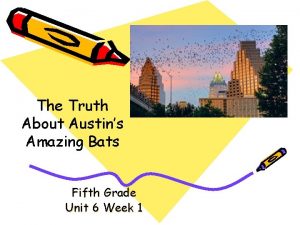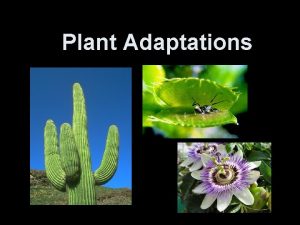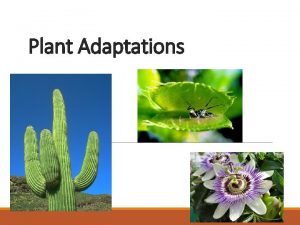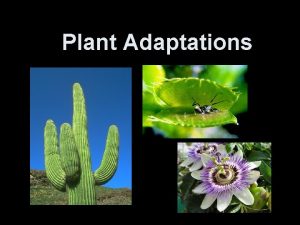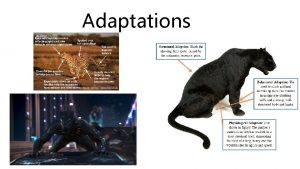Amazing Adaptations What are adaptations Adaptations are features
























- Slides: 24

Amazing Adaptations

What are adaptations? Adaptations are features that animals and plants have which allow them to live successfully in their habitats. Can you think of any?

Plants really are amazing. They have to do all the things that animals do to survive…. . but without being able to move! They have evolved some ingenious ways of surviving and thriving in the habitats where they grow. Lets find out more about some of their amazing adaptations!

Life on a mountain: what might it be like? • Cold with snow and ice • Windy and exposed • Strong sunlight • Rocks and not much soil

Life on a mountain

Life on a mountain

Life on a mountain

Life in a rainforest: what might it be like? • Wet and humid with lots of rain • Hot temperatures all the time • Competition for sunlight and space • Thin soils, rain storms

Life in a rainforest

Life in a rainforest

Life in a rainforest

Life in a desert: what might it be like? • Dry and arid, hardly any rain • Hot during the day and cold at night • Strong sunlight • Sandy loose soil, dust storms

Life in a desert

Life in a desert

Life in a desert

Plant defence Plants can’t run away from something wanting to eat them. How might a plant defend itself to stop getting munched? There are many adaptations that plants have developed to defend themselves. Here are just a few different examples…

Plant defence The Bull’s Horn Acacia is a small tree that has a special relationship with a type of Acacia ant. The ants live inside hollow thorns on the tree. The tree grows little protein nodules on its leaves that the ants can eat and also provides them with nectar. In return for a home and food, the ants will ferociously protect the tree from any animals trying to eat it by giving them a painful sting. They also clear away any seedlings that try to grow too close!

Plant defence This is a Living stone plant. It is made up of two fleshy leaves and hardly any stem. It grows really close to the ground and is protected from being eaten by its clever camouflage – animals pass it by thinking its an inedible rock! Part of the reason its so well camouflaged is because the green part of the leaf that the plant uses to catch sunlight and make its food is hidden deep inside the fleshy leaves. The top flat part of the leaf actually acts like a window and lets the light through to the green part hidden deep inside, out of sight from hungry animals!

Plant defence This is a close up of an Elephant Cactus. Looking at this picture its pretty obvious why you wouldn’t want to take a bite – its covered in sharp spines! The way the spines are arranged on the plant means that every part of the cactus is protected. Not all cacti have sharp tough spines to protect themselves, some use a type of hair-like spine called a glochid. Hairy cacti might look soft to touch but try it and those hairs will easily detach and work their way into your skin. They’re very small and fine and often have a barbed end so are very hard to get out again!

Plant defence This is a Sintensis woodruff plant. It may look pretty and like it would provide a refreshing juicy snack with all those succulent green leaves but be warned! Inside its tasty looking leaves and stems is a cocktail of chemicals, poisonous to any animals who try to eat them. Many plants contain chemicals which make them unpalatable or even poisonous to hungry animals or insects, a clever way to defend yourself without needing to move.

Compare and contrast: Mountain, Rainforest, Desert. • Which two habitats can be hot? Rainforests and deserts can both be very hot but rainforests are humid with lots of water in the air. Deserts are arid (dry), not humid. Rainforests stay a more constant temperature but deserts can be very hot during the day and cold at night. • Which two habitats can have plants with fleshy leaves? Both mountain and desert plants can have succulent fleshy leaves to store water as both habitats can be dry. Either because of lack of rain or because water is trapped as ice or snow. • Which habitat has the fastest growing plants? Rainforest plants grow quickly to compete for space and light. Desert and mountain plants are often slow growing as they only grow when there is enough water and warmth.

Your challenge: card sort Read the information on each of the plant cards to find out about their amazing adaptations. Use this information to sort and group the plants: • Into the different habitats they grow in (desert, rainforest or mountain)

Next: create your own Superplant Use what you have learnt plus your own imagination to design your own Superplant adapted to survive in the habitat conditions detailed at the top of the sheet. You can draw your plant or model it out of playdoh. Don’t forget to give your plant a name! Once you’re finished, share your plant design with the person sitting next to you. Which adaptations does your plant have, how do they help it to survive?

Finally: fill in the blanks worksheet Once you’re finished, test your knowledge by having a go at the fill in the blanks worksheet. Fantastic work! You’re now a plant adaptations expert! And remember, plants all over the world have amazing adaptations, including the ones growing in your school grounds, your local park or in your garden. Remember to keep an eye out for plant adaptations near you!
 Insidan region jh
Insidan region jh It is the basic unit of any writing composition
It is the basic unit of any writing composition My hometown is famous for several amazing natural features
My hometown is famous for several amazing natural features Amazing animals project
Amazing animals project Amazing grace, how sweet the sound
Amazing grace, how sweet the sound Amazing grace my chains are gone
Amazing grace my chains are gone Youve been amazing
Youve been amazing Computers are amazing
Computers are amazing Amazing race 12
Amazing race 12 As amazing as simile
As amazing as simile Amazing grace in russian
Amazing grace in russian Amazing magnets
Amazing magnets Indescribable you are amazing god
Indescribable you are amazing god Who breaks the power of sin and darkness
Who breaks the power of sin and darkness Amazing magnets
Amazing magnets Function of the nervous system
Function of the nervous system Austin's amazing bats
Austin's amazing bats Examples of metaphor in the most dangerous game
Examples of metaphor in the most dangerous game Fibonacci's amazing find
Fibonacci's amazing find Amazing animals project
Amazing animals project Fire sponge classification
Fire sponge classification Amazing race poland
Amazing race poland Close of probation amazing facts
Close of probation amazing facts Magnets attract and repel
Magnets attract and repel Amazing bridges in china
Amazing bridges in china
















